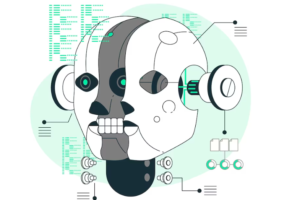With the advent of machine learning, product design will never be the same again. Machine learning has mammoth potential, but if not used well, could lead to a downhill path. It is here that user experience takes the front seat. Machine learning has to be synced with UX design to give out the most beneficial results.
Machine learning- An Overview
Machine learning is used to analyze data, find insights and predict results based on the given feedback. It’s something that contains many mathematical steps and processes, like the chain rule in calculus, in order to produce valid results. It has been in use in various business sectors like e-commerce, face recognition, cybersecurity, health, and public safety etc. There are mainly three types of machine learning algorithm:
Supervised

In this algorithm, data learned and accumulated in the past is used to predict future results. The system is trained and takes a known dataset to give out an inference. This algorithm possesses the capability of finding out errors and working towards correcting them.
Unsupervised
An unsupervised algorithm uses information which is hidden and has to be derived from intrinsic structures. This data is neither classified nor labeled. While the right output might not be available, this algorithm is used to explore unclassified data and describe hidden structures. If you are interested in finding out more, you might want to check out somewhere like https://www.thousandeyes.com/network-intelligence or somewhere similar.
There is also a semi-supervised machine learning algorithm that falls between the unsupervised and supervised category. Systems adopting this algorithm can improve learning accuracy. This algorithm is selected when the labeled data require relevant resources to analyze it.
Reinforcement
Reinforcement learning involves trial and error searches where learning is acquired through the results derived. This algorithm helps the system users and machines to ascertain the best procedure that maximizes the output. When positive results are attained, rewards are given. If the result is negative, the punishment is a repeat trial and error process that eventually leads to improvement.
How UX design is important for machine learning ?
Machine learning uses the inputs from the available data and creates feedbacks for developing the systems. This feedback, along with technology is used to creating patterns for systems. However, due to the opaque nature of the system, results are usually difficult to predict, study, and understand. This is where UX come to the rescue. It takes all the relevant data and human empathy in consideration and then converts it into a positive experience for the consumers. Since there are numerous aspects and considerations which only designers can tackle, UX becomes a necessary component for machine learning.
Let’s go by an example
As a part of her research study on machine learning, Professor LaTanya Sweeney of Harvard’s Data Privacy Lab conducted several searches on black-sounding names. It was found that Google displayed sponsored ads related to arrest. Sweeney then searched her own name which pulled out search results like “LaTanya Sweeney arrested?”, whereas Professor Sweeney held no criminal record.
The problem
As we see, algorithms and machine learning without any UX experience could lead to faulty results which could sometimes tarnish the reputation of people. Machine learning needs a hybrid language where engineering and design are combined to make the system easy for the user to understand. Transparency generates trust of the user in the system.
Now let’s talk in terms of product design. Over the years, the expectation of the users from the product design has significantly increased. However, data-driven decisions for UX are still given precedence over human behavior as data is always backed by a scientific base. Sometimes UX designs rely primarily on the designer’s decision which could be biased. Hence, the data has to be associated with human empathy for designing a great user experience.
The solution
Imagine a situation where a person has a certain preference and tastes. However, due to changes in his age/health condition, his preference takes a different turn. Designers make use of user personas to build products by studying user demographics. In the above case, the user’s preference has changed since they were last analyzed, hence the final product may not seem useful to him anymore, leading to a decline in the demand.
The solution lies in embracing a quantitative approach which involves thorough research and analysis. The next stage involves identifying patterns in the collected data. A user might go online every day – is a generic collection of data. The user logins every day from 8-9 pm- this is the exact data. These small variables can prove pivotal in shaping products for a complete user experience. And lastly, it is important to measure the changes in the data. In the above example, if the person stops logging in at 8 pm every day, there could be a reason attached to it. If the machine learning system is equipped to predict this change, then more superior product designs can be built.
This type of analysis is also used in malware analysis, prediction, and security event clustering. It can be used to detect previously unknown attacks that do not have a known signature. Machine learning might allow cybersecurity systems that people like this company offering cybersecurity services in Denver might use to analyze and learn from patterns to help prevent similar attacks and respond to changing behavior. It can assist cybersecurity teams in becoming more proactive in preventing threats and responding to active attacks in real-time. Pradeo, a Mobile application testing software, can be an example of machine learning and AI combined to prevent a mobile data breach.
Wrap-up
Machine intelligence is essential for constant improvisation of a system/machine. Often designers have to step into the shoes of the user to design products that provide an incredible user experience. The products that are built require specific algorithms that are powerful enough to identify and analyze data and provide a relevant outcome.





